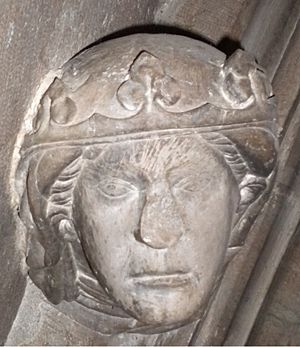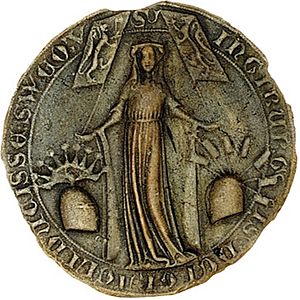Ingeborg of Norway facts for kids
Quick facts for kids Ingeborg of Norway |
|
|---|---|
| Duchess of Södermanland, Halland, and Estonia | |

Duchess Ingeborg's bust at Linköping Cathedral
|
|
| Born | 1301 Norway |
| Died | 1361 (aged 59–60) |
| Spouse | Eric, Duke of Södermanland Canute Porse, Duke of Halland |
| Issue | Magnus VII of Norway Euphemia, Duchess of Mecklenburg Haakon, Duke of Halland Canute, Duke of Halland |
| House | Sverre |
| Father | Haakon V of Norway |
| Mother | Euphemia of Rügen |
Ingeborg of Norway (born 1301 – died 17 June 1361) was a Norwegian princess. She became a duchess in Sweden through marriage. Ingeborg played a very important role in the governments of both Norway and Sweden.
She was a regent for her young son, King Magnus, who ruled both Norway and Sweden. From 1318 to 1319, she was the de facto (in practice) ruler of Sweden. From 1319 to 1326, she was Sweden's first de jure (by law) female regent. Her actions greatly influenced the history of northern Europe.
Contents
Life Story
Early Years
Ingeborg was born in 1301. She was the only daughter of King Håkon V of Norway and Queen Euphemia.
As a child, she was first promised in marriage to Magnus Birgerson, the son of the Swedish king. However, this engagement was later called off due to changing political reasons. In 1305, she was instead promised to Eric, Duke of Södermanland. Eric was a younger brother of King Birger of Sweden.
In 1312, Ingeborg and Eric officially married in Oslo. At the same time, her cousin, also named Ingeborg, married Eric's brother, Duke Valdemar Magnusson. At her wedding, Queen Euphemia shared famous poems, known as the Euphemia songs. Ingeborg and Eric had two children before Duke Eric was sadly killed.
Leading the Ducal Party
After her husband and his brother were imprisoned, Ingeborg and her cousin (who was also her sister-in-law), Ingeborg Eriksdottir, took charge. They became the leaders of their husbands' supporters.
In April 1318, the two Duchesses Ingeborg made an agreement in Kalmar. They worked with Duke Christoffer of Denmark and Archbishop Esgar of Lund. Their goal was to free their husbands. They promised not to make peace with the kings of Sweden and Denmark until their husbands were free. Later that year, it was confirmed that their husbands had died.
Becoming a Regent
When Ingeborg's father died, her son Magnus VII of Norway became King of Norway. He was only three years old. Ingeborg was officially recognized as his regent in Norway. A regent is someone who governs a country when the king or queen is too young or unable to rule.
Soon after, the Swedish nobles chose young Magnus to be King of Sweden. They removed the previous king, Birger. Ingeborg was then made the regent of Sweden as well. She was given a seat and a vote in the Swedish government. Her title was: "Ingeborg, by the Grace of God, daughter of Haakon, duchess in the Kingdom of Sweden." Duchess Ingeborg had her own court at her home in Varberg.
Letters from 1318-1321 show that powerful Swedish men used Ingeborg's position. They had her issue documents under her own seal. These documents benefited them as a reward for supporting her murdered husband and her son's right to the throne.
Ingeborg was the only person who had a seat in both the Swedish and Norwegian regency councils. She was also the duchess of her own lands, which she ruled independently. She controlled many castles that were important because of their location.
Trusted Advisors
Ingeborg was sometimes criticized for making political decisions without asking the Swedish and Norwegian councils. She was also criticized for using her son's royal seal for her own plans.
On October 1, 1320, she helped the city of Riga with its debts, acting on behalf of her son. She was known for giving large gifts to her supporters. Canute Porse was one of her husband's supporters. He was made governor of Varberg. Ingeborg surrounded herself with young foreign men who were thought to influence her decisions. Canute was the most well-known of these.
In April 1321, the Swedish council received complaints from the Norwegian council. There were rumors of crimes and problems in Ingeborg's lands caused by foreigners. The Swedish council advised Ingeborg to listen more to older, experienced men in the councils. They suggested she should not listen as much to young, inexperienced foreign men. A new law was even created. It stopped foreigners from being members of the Swedish council or from controlling Swedish castles.
The Scania Plan
Ingeborg and Canute wanted to make Scania, which was then part of Denmark, a part of her own lands. In 1321, Ingeborg arranged for her daughter Euphemia to marry Albert II, Duke of Mecklenburg. This marriage agreement stated that Mecklenburg and other regions would help Ingeborg conquer Scania.
The Norwegian council approved this plan, but the Swedish council did not. To pay for the invasion, Ingeborg borrowed money from the city of Stralsund. She offered free trade in Sweden and Norway as a guarantee. When Ingeborg's forces, led by Canute, invaded Scania in 1322–23, Mecklenburg betrayed her. They sided with Denmark, and the alliance broke apart.
Losing Power
In 1322, Ingeborg had a clear disagreement with the Swedish regency council. The council decided that no order from Ingeborg would be accepted without their full approval. Any agreements she had made with individual council members were canceled. In 1323, Ingeborg had to agree to these terms. She also had to give up several of her important castles and lands.
On February 20, 1323, the Norwegian regency council also turned against Ingeborg. They accused her of misusing the royal seal, breaking peace with Denmark, and causing high costs. She was replaced as the head of the regency. After 1323, Ingeborg's power was limited to what the councils approved. This meant they had effectively removed her from power.
On February 14, 1326, Ingeborg gave up more lands. In return, her debts were paid. She was also forced to send Canute into exile. She lost all political power in the Swedish regency council. However, her signature was still needed for the peace treaty between Norway and Sönderjylland on June 14, 1327.
Ingeborg married her beloved Canute Porse on June 21, 1327. Canute was a noble, but not from a royal family. Canute became Duke of Halland in 1326. This new marriage was another reason why the Swedes, and more Norwegians, did not allow Ingeborg to use her government power. In the same year she married Canute, Ingeborg also lost her power in the Norwegian regency council.
Later Life
Her husband, Canute, became Duke of Estonia in 1329. Sadly, Ingeborg became a widow again on May 30, 1330, when Canute was killed. Her younger sons then became dukes of Halland.
Her eldest son, King Magnus, became an adult in 1332. That same year, Ingeborg helped Sweden gain control over Scania until 1360. After her second husband's death, Ingeborg again took an important role in her son the king's life. However, we don't know exactly how much influence she had on him.
In 1336, Ingeborg welcomed her daughter Euphemia and her son-in-law Albert of Mecklenburg to Stockholm. They came with others for the coronation of her son and his wife. In 1341, Ingeborg and some counts went to war against Valdemar of Schleswig and others in Denmark. Ingeborg was staying at Kalundborg in Denmark when King Valdemar IV attacked her. After two years of fighting and agreements, the issue was settled. King Magnus helped seal the peace by telling Valdemar to keep his promise to Ingeborg. In 1350, Ingeborg inherited the title of Duke of Halland from her younger son.
Children and Family
With Eric, Duke of Södermanland, Ingeborg had two children:
- Magnus VII of Norway (1316–1374)
- Euphemia of Sweden, duchess of Mecklenburg (1317–around 1370)
With Canute Porse, Duke of Halland and Estonia, Ingeborg had three children:
- Haakon, Duke of Halland, died 1350
- Canute, Duke of Halland, died 1350
- Bridget, who married Jon Hafthorsson and had children
Legacy
Ingeborg has been called one of the three most amazing Scandinavian women in European history. The other two are Saint Bridget and Queen Margaret of Scandinavia.
The story of Ingeborg's second marriage and her son Haakon's possible claim to the Norwegian throne is an important part of the novel Kristin Lavransdatter by Sigrid Undset.
See also
In Spanish: Ingeborg de Noruega para niños


